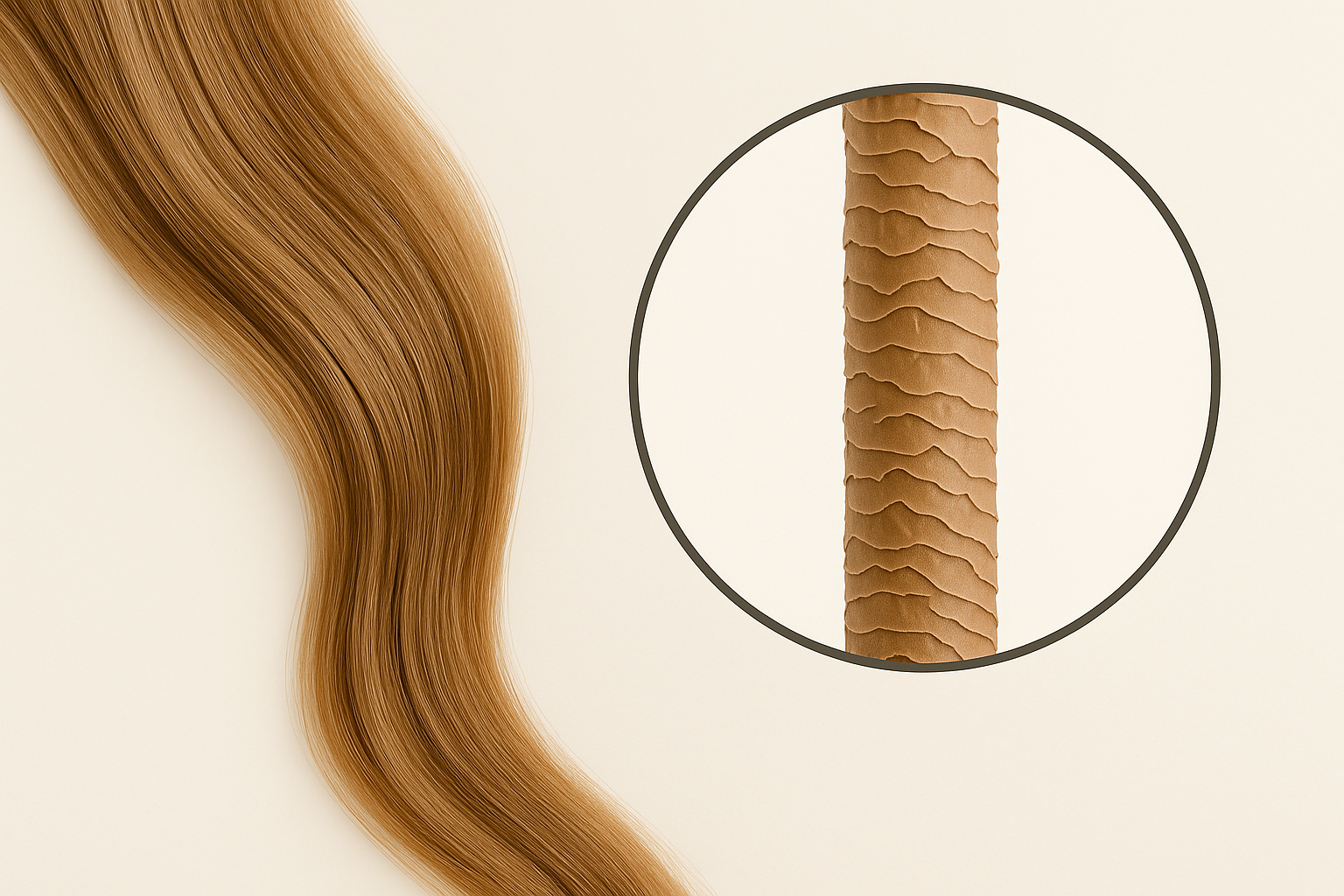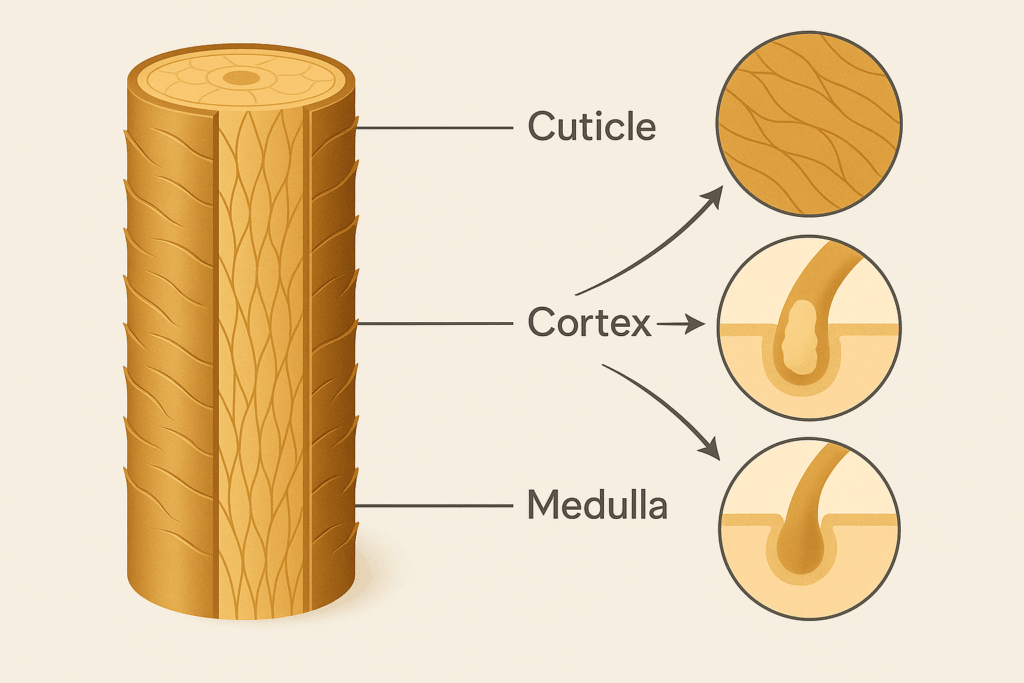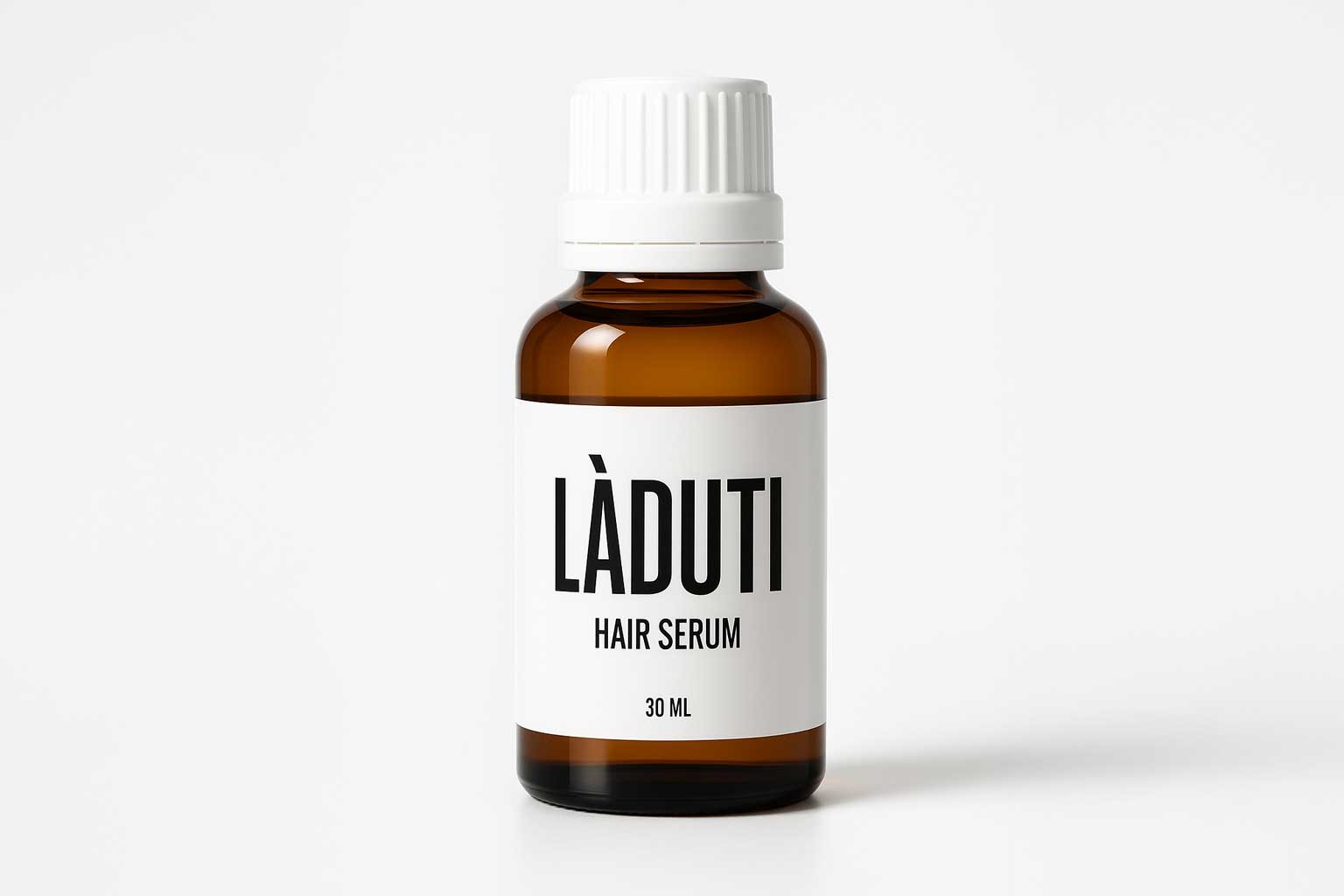Hair Structure Explained: How it Affects Your Hair Growth

The hair structure describes the inner and outer structure of each individual hair. It determines how thick, strong or elastic your hair is and has a significant influence on hair growth. If you understand your hair structure, you can make more targeted care and treatment choices and promote healthier and thicker hair in the long term.
1. The detailed structure of hair
1.1 The cuticle layer (cuticle)
The cuticle is the outermost layer of the hair and consists of tiny horny cells that lie on top of each other like roof tiles. This structure makes the hair resistant to external influences - but only as long as it is intact.
Functions of the cuticle
- Protective shield: It protects the hair from UV rays, pollutants, heat and mechanical influences.
- Determination of shine and suppleness: A smooth cuticle reflects light, making the hair shiny and supple.
- Consequences of damage: If the cuticle layer is roughened, the hair appears dull, rough and tends to break more quickly. Common causes are heat, coloring or aggressive shampoos.
Tip: Products with nourishing oils such as argan or jojoba oil can smooth the cuticle and add shine.
1.2 The fiber layer (cortex)
The cortex forms the largest part of the hair. It consists of keratin fibers that ensure the strength and elasticity of the hair. It also contains the pigments that determine our hair color.
Why is the cortex important?
- Stability & tear resistance: The cortex makes the hair resistant to tension and pressure.
- Color: This is where the melanin is located, which is responsible for the individual hair color.
- Basis for growth: As the thickness and quality of hair is formed in the cortex, it is crucial for the general hair structure.
Tip: Care products containing protein can strengthen the cortex by partially replacing lost keratin.
1.3 The hair marrow (medulla)
The medulla is the innermost layer of the hair. It is not equally pronounced in all hair types - fine hair often has no or only a very thin medulla.
Influence of the medulla
- Volume & density: With thicker hair, the medulla helps to make the hair appear fuller.
- Mechanical stability: It supports resilience and ensures that the hair is less susceptible to breakage.
Tip: As the medulla is difficult to influence, care and nutrition should focus on strengthening the outer layers (cuticle & cortex).

2. The Impact of Hair Structure on Hair Growth
2.1 Thick vs. fine hair
- Thick hair: It is more resistant and automatically appears fuller and shinier. However, they can also be more stubborn.
- Fine hair: It is more sensitive, breaks more quickly and requires strengthening care to improve its stability.
Care tip for fine hair: Products with proteins or collagen can strengthen the hair structure and visually give it more volume.
2.2 Curly or straight
The shape of the hair follicles determines whether hair grows straight, wavy or curly.
- Curly hair: As the cuticle is more open, curly hair loses moisture more quickly. It tends to be dry and frizzy. Rich oils and moisturizing masks help here.
- Straight hair: Reflects light better and therefore looks shinier. It often becomes greasy more quickly as sebum reaches the lengths more easily from the roots.
Care instructions: Curly hair needs moisture above all, whereas straight hair needs light care that does not weigh it down.
3. Genetics, Nutrition and Care
Hair structure is primarily genetically determined - but it can be influenced by lifestyle and care.
3.1 Genetic factors
Genes determine the basic structure (thick, fine, smooth, curly). Only limited changes can be made here.
3.2 Nutrition & nutrients
A balanced diet can have a positive effect on hair quality. This is particularly important:
- Biotin: Supports hair metabolism and keratin formation.
- Zinc: Strengthens the hair roots and promotes cell division.
- Vitamin D & iron: Crucial for the oxygen supply and activation of the hair follicles.
3.3 Stress & lifestyle
Chronic stress, lack of sleep or smoking can worsen the hair structure. A healthy lifestyle also has an effect on hair quality.
4. Tips for strengthening hair structure
4.1 Gentle care
Heat, chemical treatments or aggressive products damage the cuticle.
- Less heat: Avoid using straighteners or very hot blow-dryers as often as possible.
- Mild shampoos: Gently cleanse and preserve the natural protective layer.
- No aggressive treatments: Perms, bleaching or strong coloring attack the hair structure massively.
Care goal: An intact cuticle is the basis for shiny, healthy hair.
4.2 Promoting scalp health
A healthy scalp is the foundation for strong hair.
- Head massages: Promote blood circulation and stimulate the hair roots.
- Active ingredients such as caffeine or rosemary: can improve microcirculation and activate the hair follicles.
4.3 Optimize nutrient intake
In addition to a balanced diet, serums with caffeine, biotin or plant extracts can specifically nourish the hair roots. These active ingredients act directly on the follicles and strengthen the hair structure from the inside out.
Conclusion: Hair structure is the key to beautiful hair
The hair structure not only determines the appearance of your hair, but also its ability to grow.
A premium hair serum like Laduti combines many proven active ingredients:
- Biotin → Strengthens the hair metabolism
- Caffeine → Stimulates the hair roots and can prolong the growth phase
- Herbal extracts such as rosemary and ginseng → Promote blood circulation to the scalp
- Procapil™ & AnaGain™ → Innovative active ingredient complexes to support the hair follicles
This optimizes the natural growth conditions without risky promises - but through a cleverly coordinated combination of active ingredients.

FAQ
How do I find out my hair structure?
Fine hair often appears soft and brittle, thick hair more stable. A professional hair analysis at the hairdresser's provides clarity.
Can the hair structure change over the course of a lifetime?
Yes, due to hormones, age, illness or external influences.
Which nutrients are crucial for healthy hair?
Especially biotin, zinc, iron and vitamin D.
Can the hair structure be permanently changed?
The genetic basis remains, but the appearance and resistance can be improved through care and active ingredients.
What influence does styling have on the hair structure?
Frequent colouring, heat from straighteners or hair dryers and chemical treatments can weaken the hair structure. Gentle styling and heat protection products help to keep hair healthy.

